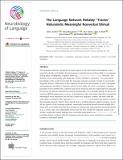| dc.contributor.author | Sueoka, Yotaro | |
| dc.contributor.author | Paunov, Alexander | |
| dc.contributor.author | Tanner, Alyx | |
| dc.contributor.author | Blank, Idan A. | |
| dc.contributor.author | Ivanova, Anna | |
| dc.contributor.author | Fedorenko, Evelina | |
| dc.date.accessioned | 2024-11-22T20:52:40Z | |
| dc.date.available | 2024-11-22T20:52:40Z | |
| dc.date.issued | 2024-06-03 | |
| dc.identifier.issn | 2641-4368 | |
| dc.identifier.uri | https://hdl.handle.net/1721.1/157662 | |
| dc.description.abstract | The language network, comprised of brain regions in the left frontal and temporal cortex, responds robustly and reliably during language comprehension but shows little or no response during many nonlinguistic cognitive tasks (e.g., Fedorenko & Blank, 2020). However, one domain whose relationship with language remains debated is semantics—our conceptual knowledge of the world. Given that the language network responds strongly to meaningful linguistic stimuli, could some of this response be driven by the presence of rich conceptual representations encoded in linguistic inputs? In this study, we used a naturalistic cognition paradigm to test whether the cognitive and neural resources that are responsible for language processing are also recruited for processing semantically rich nonverbal stimuli. To do so, we measured BOLD responses to a set of ∼5-minute-long video and audio clips that consisted of meaningful event sequences but did not contain any linguistic content. We then used the intersubject correlation (ISC) approach (Hasson et al., 2004) to examine the extent to which the language network “tracks” these stimuli, that is, exhibits stimulus-related variation. Across all the regions of the language network, meaningful nonverbal stimuli elicited reliable ISCs. These ISCs were higher than the ISCs elicited by semantically impoverished nonverbal stimuli (e.g., a music clip), but substantially lower than the ISCs elicited by linguistic stimuli. Our results complement earlier findings from controlled experiments (e.g., Ivanova et al., 2021) in providing further evidence that the language network shows some sensitivity to semantic content in nonverbal stimuli. | en_US |
| dc.language.iso | en_US | |
| dc.publisher | MIT Press | en_US |
| dc.relation.isversionof | https://doi.org/10.1162/nol_a_00135 | en_US |
| dc.rights | Creative Commons Attribution | en_US |
| dc.rights | An error occurred on the license name. | * |
| dc.rights.uri | https://creativecommons.org/licenses/by/4.0/ | en_US |
| dc.source | MIT Press | en_US |
| dc.title | The Language Network Reliably “Tracks” Naturalistic Meaningful Nonverbal Stimuli | en_US |
| dc.type | Article | en_US |
| dc.identifier.citation | Yotaro Sueoka, Alexander Paunov, Alyx Tanner, Idan A. Blank, Anna Ivanova, Evelina Fedorenko; The Language Network Reliably “Tracks” Naturalistic Meaningful Nonverbal Stimuli. Neurobiology of Language 2024; 5 (2): 385–408. | en_US |
| dc.contributor.department | Massachusetts Institute of Technology. Department of Brain and Cognitive Sciences | en_US |
| dc.contributor.department | McGovern Institute for Brain Research at MIT | en_US |
| dc.relation.journal | Neurobiology of Language | en_US |
| dc.eprint.version | Final published version | en_US |
| dc.type.uri | http://purl.org/eprint/type/JournalArticle | en_US |
| eprint.status | http://purl.org/eprint/status/PeerReviewed | en_US |
| dspace.date.submission | 2024-11-22T20:14:13Z | |
| mit.journal.volume | 5 | en_US |
| mit.journal.issue | 2 | en_US |
| mit.license | PUBLISHER_CC | |
| mit.metadata.status | Authority Work and Publication Information Needed | en_US |
